Liquidity Flywheel Drives Binance to 300 Million Users

The changing face of US exchange liquidity

Welcome to the Data Debrief!
Welcome to the Data Debrief! Despite the strong debut of spot ETH ETFs, last week, ETH closed the week in the red. BTC, on the other hand, rose after US Presidential candidate Donald Trump said he would create a Bitcoin stockpile if reelected. Senator Cynthia Lummis later announced a proposed bill for the US Treasury to buy 1 million BTC as a strategic reserve. This week, we’ll be exploring:
-
Liquidity on US Exchanges
-
ETH dips following ETF debut
-
Crypto’s weak correlation to tech stocks
Trend of the Week
The changing face of US exchange liquidity.
Liquidity has increased across crypto exchanges throughout 2024 as sentiment improved and trading volumes picked up. The rise has been particularly noticeable for BTC markets in the US, compared to offshore exchanges. The approval of spot BTC ETFs in the US this year has likely contributed to the increase, as more institutional firms participate in the market.
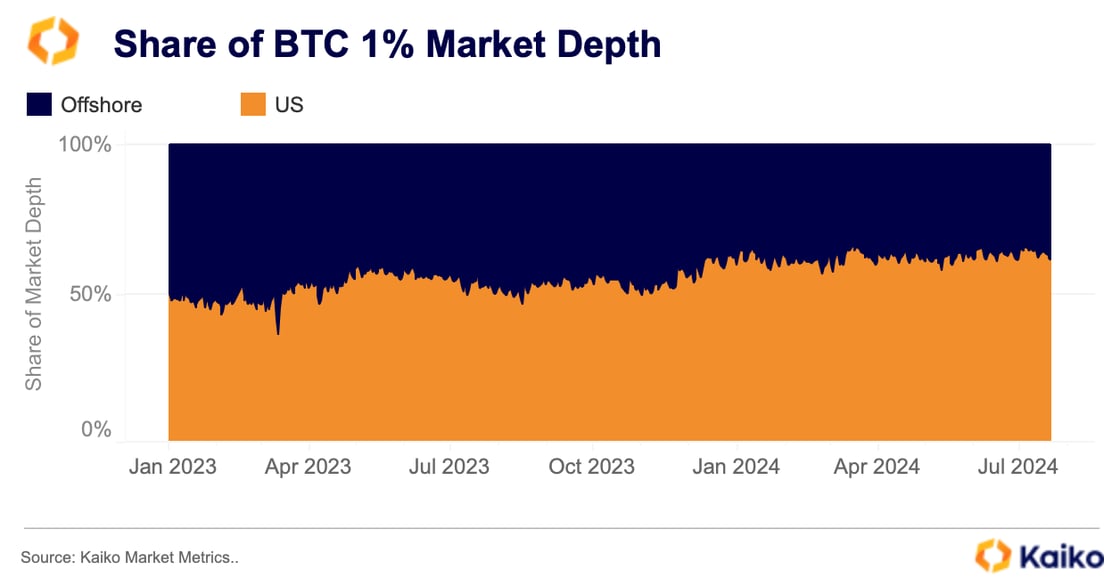
US exchanges now account for over 60% of BTC’s 1% market depth, up from around 45% at the beginning of 2023.
We observe a similar trend when examining BTC trade volume relative to altcoins, which has increased on US exchanges while retreating on offshore markets. Historically, BTC dominance has been higher on US platforms due to higher institutional participation in the US, with traders preferring BTC over riskier altcoins. Interestingly, despite BTC’s price decline in Q2, BTC’s share on US markets continued increasing, suggesting that the launch of spot ETFs could further exacerbate this trend.
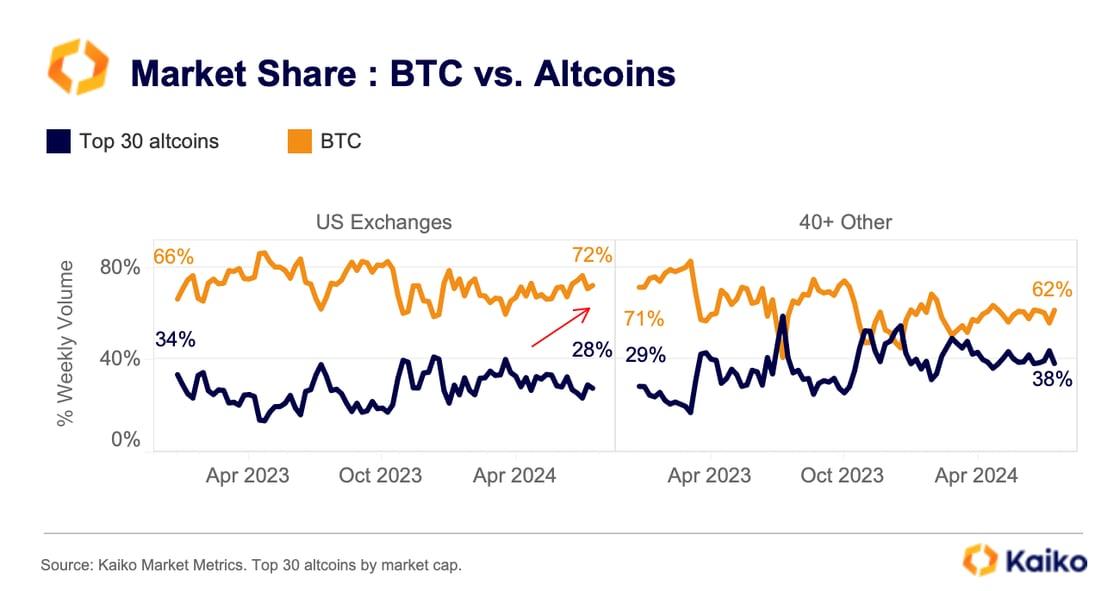
The picture is different when it comes to ETH. Offshore exchanges have gained relative to US exchanges when it comes to ETH’s 1% market depth since January. US exchange’s market share grew in the first quarter of the year. It peaked around 70% in March, but has since fallen to 56%.

With the approval and launch of spot ETH ETFs in the US this trend could reverse in time as more institutional firm’s access ETH.
The shift could take more time to unfold as we are currently in a slow volume period with many market participants taking a break during the summer. Both ETH volume and depth remained surprisingly flat following the long-awaited launch of spot ETFs last week. While ETH’s 0.1% market depth (close to the mid-price) edged up to $18 million, it still fell short of June’s highs of $23 million. Interestingly, ETH bid depth has been surpassing ask depth on US platforms prior to the launch, with a particularly large imbalance on Kraken and Bitstamp.
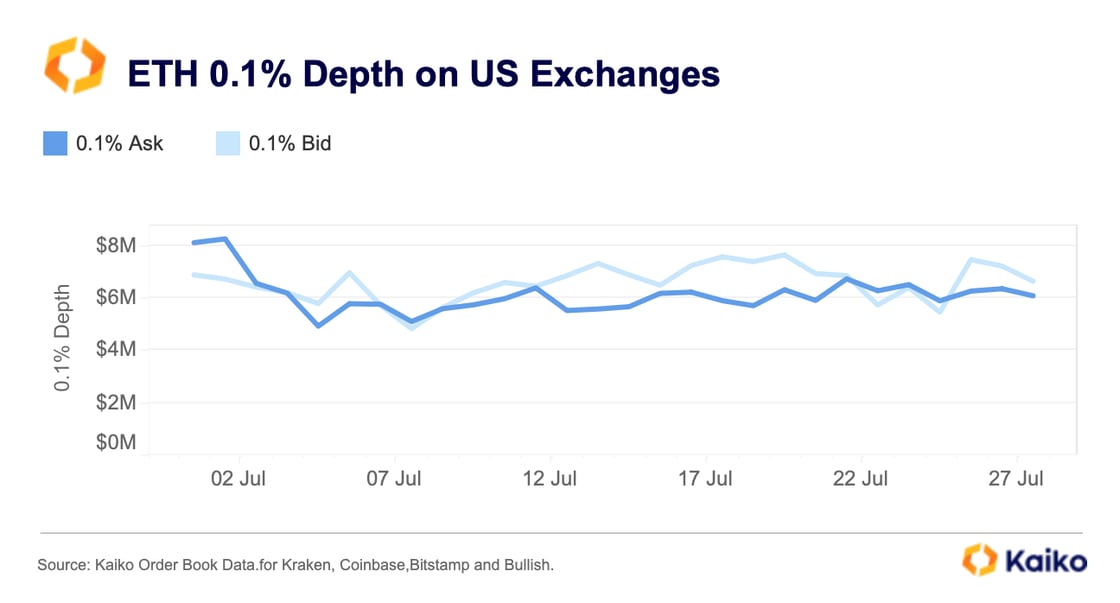
Typically, an increase in bid depth indicates a buildup of limit orders on the buy side of the order book. However, decline in ETH prices post-launch last week suggests that selling pressures were also present.
Never miss an analysis.
Subscribe to our free weekly Data Debrief email, or learn more about our premium research subscriptions here.
Data Points
ETH dips despite strong ETFs debut.
Two months after their unexpected approval in May, nine new spot ETH ETFs began trading in the US last week. On their first day of trading, they attracted $1.1 billion in trade volume, about 20% of the first-day trade volume of BTC ETFs. Excluding Grayscale’s conversions of GBTC and ETHE, the ETH ETFs’ first-day volume was more than 80% of BTC ETFs’ volume. This suggests significant investor interest, despite typically lower market participation during the summer months.
 Despite the strong start of spot ETH ETFs, ETH prices fell by more than 6% last week as ETHE outflows weighed on market sentiment.
Despite the strong start of spot ETH ETFs, ETH prices fell by more than 6% last week as ETHE outflows weighed on market sentiment.
Three days after its conversion, ETHE saw $1.15 billion in outflows, which is approximately 12% of its AUM on launch day. This is a much faster pace than GBTC, which saw outflows amounting to only 4% of its AUM during the first three days of trading as an ETF.
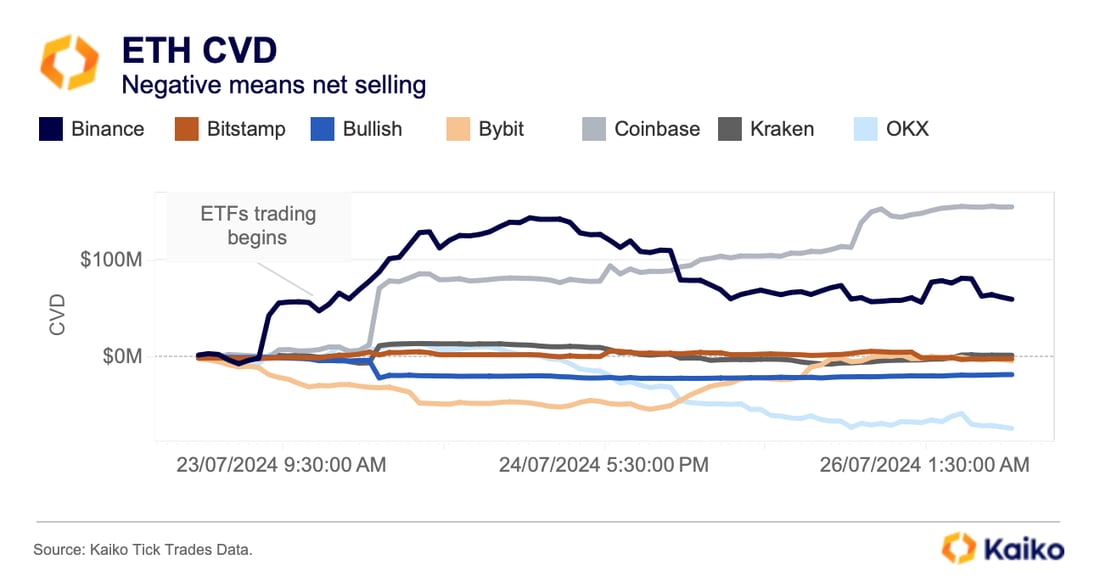
Looking at ETH spot markets, the cumulative volume delta (CVD) diverged between exchanges. A negative CVD indicates net selling and vice versa. In the first hours surrounding the U.S. market open, ETH saw strong buying on Coinbase and Binance. However, selling outpaced buying on OKX, Bullish, and other smaller exchanges, suggesting some traders took profit.
BTC and ETH remain weakly correlated with US tech
In the second quarter, the correlation between BTC and ETH with the Nasdaq 100 increased slightly after hitting a multi-year low in March. However, both remain weakly correlated with US tech equities, with 90-day correlations of 0.16 (BTC) and 0.19 (ETH), much lower than their 2022 peaks of over 0.5.
Interestingly, since May, ETH has been slightly less correlated to US tech equities than Bitcoin for the first time since 2022.
In July, the US equity markets, saw a significant shift as large tech stocks lost momentum while small caps gained. This rotation was driven by rising expectations of rate cuts due to weakening US economic data and cooling inflation.
The low correlation of BTC and ETH with the Nasdaq makes them attractive portfolio diversifiers, improving the risk-return trade-off (more return for similar risk). However, the introduction of spot ETFs for both BTC and ETH will prompt institutional investors to distinguish between the two assets’ unique characteristics and risks when structuring their portfolios and building their strategic asset allocations.
Traders pile into US election contracts.
Options traders flocked to bullish bets on BTC for Deribit’s new US election contracts. The options contracts, which expire on November 8 three days after the US Presidential elections, went live on July 18.
Traders bought $41mn worth of BTC calls on Tuesday July 23. Weekend trade volumes spiked on Saturday as Republican candidate former President Donald Trump spoke during the Bitcoin 2024 conference in Nashville. Options traders bought $8mn worth of calls during the final day of the conference.
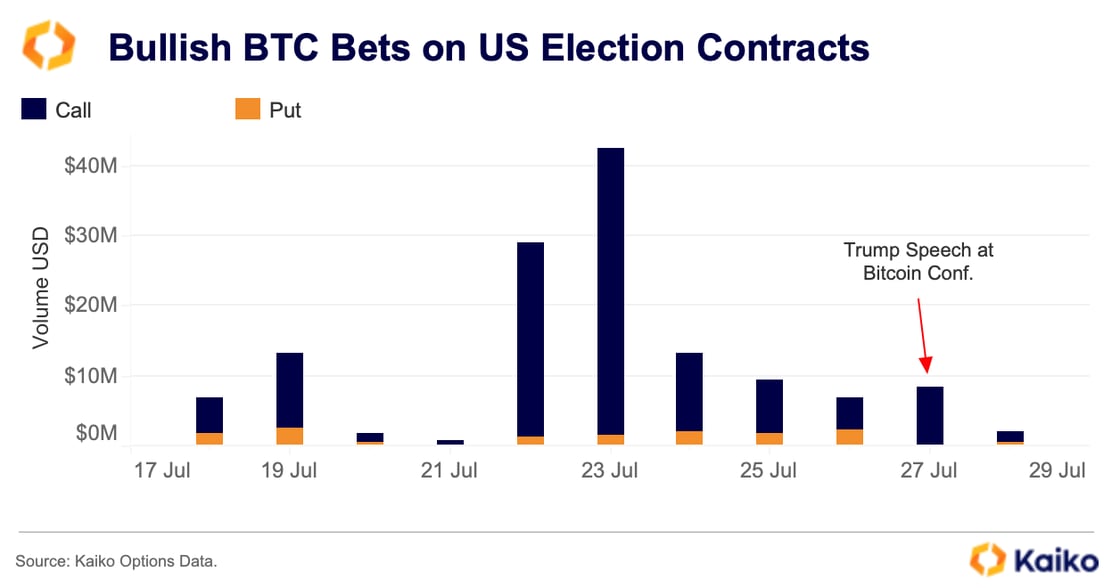
These call options give buyers the right to buy BTC at a specified price on expiration, they will be in profit (or in-the-money) if BTC is above the strike price at expiration.
The highest volume strike for BTC contracts expiring on November 8 was on the $75,000 strike, made up mostly of call options, according to Kaiko Options data. These bullish bets likely reflect traders growing conviction that the former President will win in November. The Republican candidate said he would embrace cryptocurrency and Bitcoin technology on Saturday and pledge not to sell any seized BTC the US government owned if elected.
There was considerably less action when it comes to the same contracts for ETH options on Deribit. The concentration of volume on BTC bets reflects the assets dominance during this year’s bull run.
The newly created ETH contracts experienced a spike in volume on Monday, ahead of last Tuesday’s spot ETF launch in the US. Traders bought $7mn worth of calls on ETH and $1mn worth of puts — which pay off if ETH price falls.
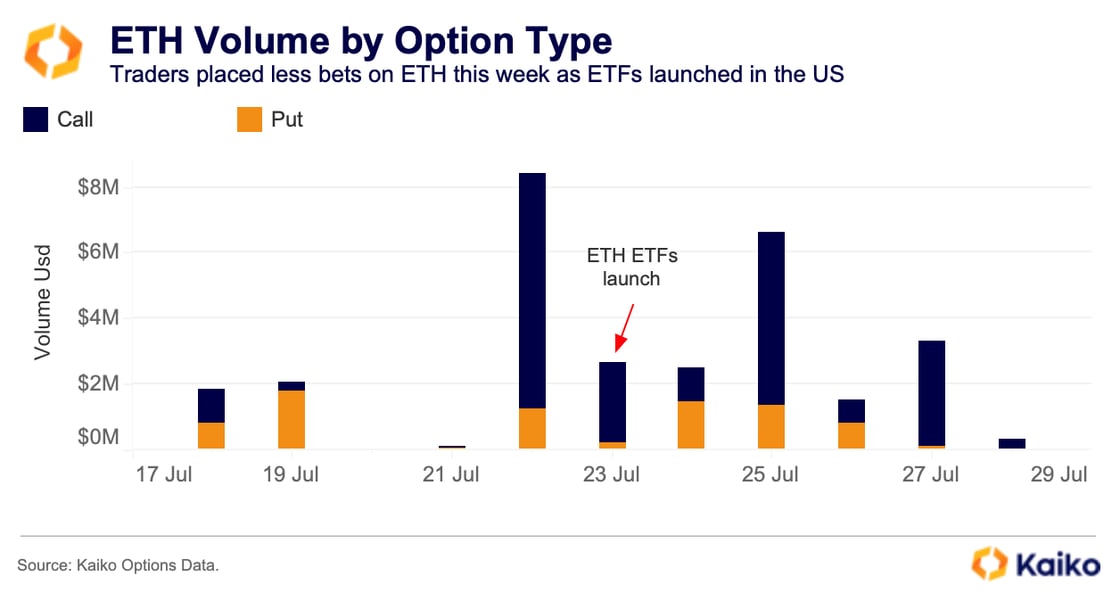
While volumes were much smaller than the equivalent contracts for BTC they remained very bullish. Most options volume for ETH on this expiry coalesced around strike prices between $4,500 and $6,000.
RUB and UAH volume decline since the start of the war.
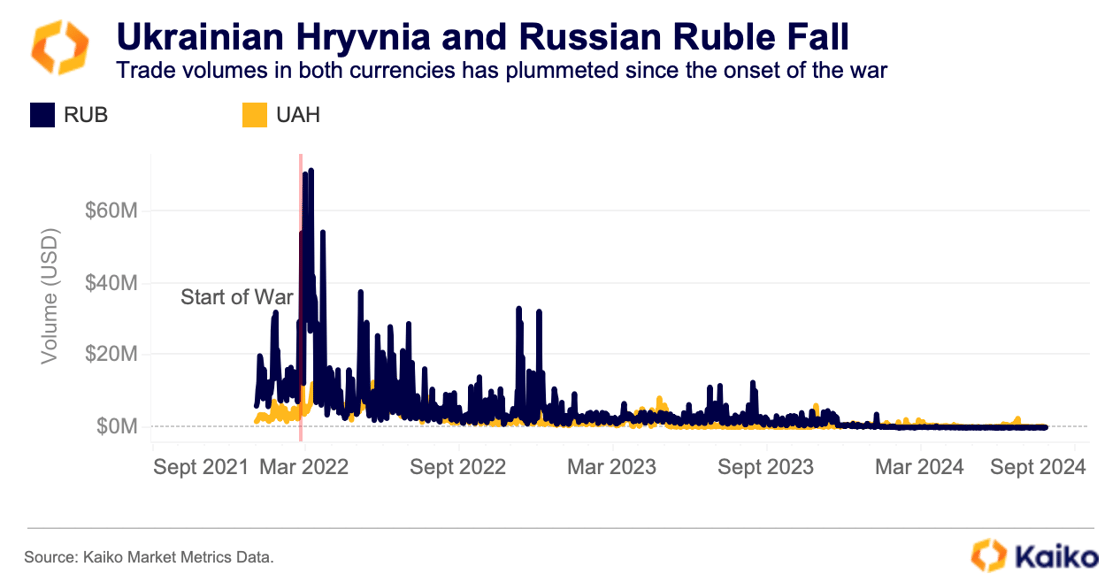
Crypto trade volumes in Ukrainian Hryvnia and Russian Ruble has plummeted since the onset of the war in February 2022. BTC traded at a 6% premium on Binance’s Ukrainian Hryvnia (UAH) market as demand for cryptocurrencies soared immediately following Russia’s invasion.
That initial spike has faded and UAH volumes have fallen consistently ever since. However, RUB volumes have experience some spikes in the intervening period — despite most exchanges removing support for Russian pairs.
Yobit is the only exchange Kaiko’s coverage offering RUB pairs versus cryptocurrencies. HTX had offered support for some RUB pairs in January 2023, but it removed these pairs in June. Binance fully exited the Russian market after media reports last summer that it helped customers move funds held in sanctioned Russian banks.
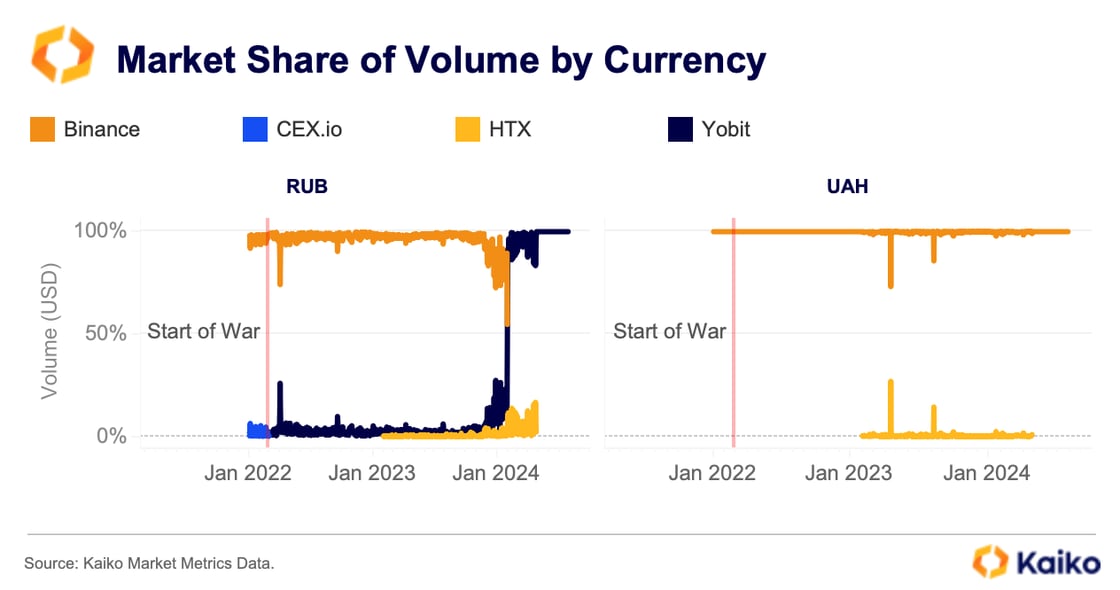
The exchange sold its Russian business to CommEX in September 2023 and ended RUB peer-to-peer support on Jan 31, 2024. CommEX has since closed.
Turkish traders prefer meme tokens and stablecoins to BTC.
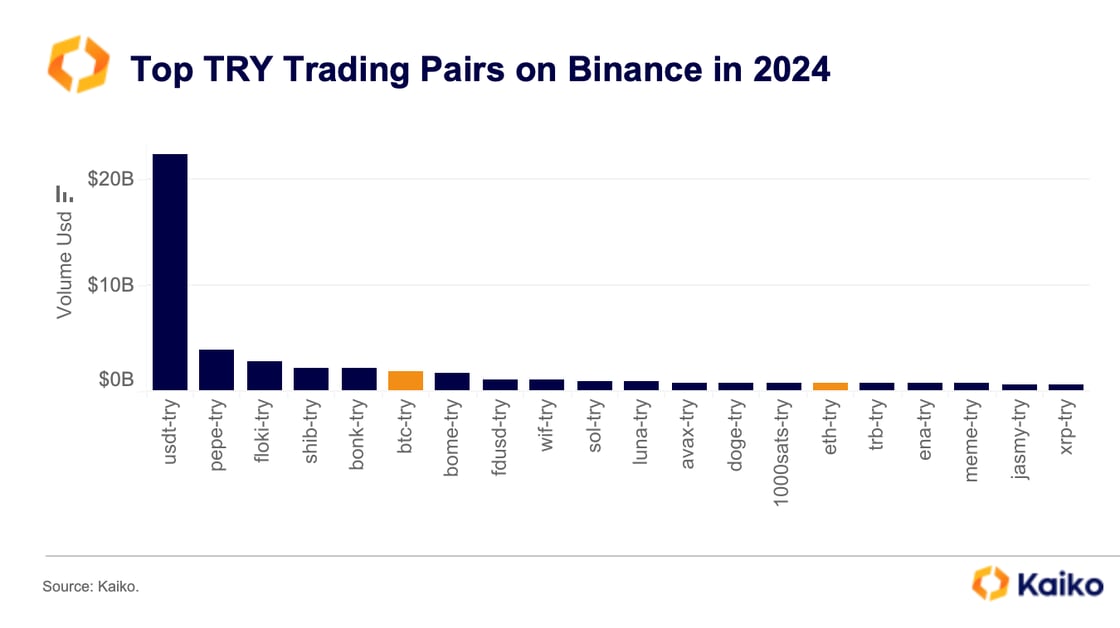
The Turkish crypto market has seen remarkable growth in recent years. Over half of the country’s population has now invested in crypto. The surge in activity is largely due to macroeconomic factors, such as high inflation and currency devaluation. This has significantly boosted the use of stablecoins over the past years.
In 2024, USDT-TRY is by far the largest trading pair by volume on Binance with more than $22bn.
However, Turkish traders have also turned to riskier crypto assets to hedge against currency volatility and speculate. Meme tokens have all surpassed Bitcoin in trade volume this year. For a more detailed analysis of the Turkish market, check out our lastest Deep Dive here.
Data Used In This Analysis

More From Kaiko Research
![]()
Derivatives
22/12/2025 Data Debrief
Crypto in 2026, What Breaks, What Scales, What ConsolidatesCrypto markets enter 2026 in a markedly different position than in prior cycle transitions. Rather than resetting after a speculative peak, the market appears to be progressing through a phase of institutional consolidation.
Written by Thomas Probst![]()
Year in Review
01/12/2025 Data Debrief
Kaiko Research's Top 10 Charts of 2025In this report, we look back on 2025 and the key forces that shaped markets. From BTC record highs and fleeting altcoin rallies to major liquidation events and evolving regulation, we examine what shaped a seminal year for crypto.Written by Adam Morgan McCarthy![]()
Stablecoin
24/11/2025 Data Debrief
MiCA's Impact on Crypto in EuropeEurope is progressing with a conservative structured crypto framework that leans towards regulating innovation.Written by Adam Morgan McCarthy![]()
Macro
17/11/2025 Data Debrief
Navigating Fed Fears & AI Bubble BurstingGiven the current macroeconomic context, we are seeing the emergence of two major risks likely to have a decisive impact.
Written by Adam Morgan McCarthy





